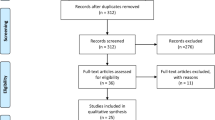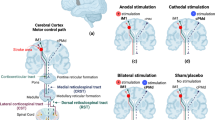Abstract
More than half of stroke patients experience sensory dysfunction that affects their quality of life. Previous training modalities are ineffective in improving sensory function. In contrast, non-invasive brain stimulation (NIBS) is a new promising intervention for stroke rehabilitation. The aim of this meta-analysis was to summarize the current effectiveness of NIBS in the treatment of post-stroke sensory dysfunction. Articles published in PubMed, Web of Science, Embase, China National Knowledge Infrastructure (CNKI), Chinese scientific journals full-text database (VIP), and Wanfang database from the inception to March 8, 2023 were searched. There were no restrictions on language. A total of 14 RCTs were included (combined n = 804). Moderate-quality evidence suggested that NIBS significantly improved sensory function after stroke, and significant effects were observed up to 1 year after the intervention. In subgroup analysis, treatment with transcranial direct current stimulation (tDCS) or repetitive transcranial magnetic stimulation (rTMS) was significantly more effective than controls for recovery of sensory function in stroke patients. Stimulation of the primary motor cortex (M1), primary somatosensory cortex (S1) or M1 + S1 stimulation sites significantly improved sensory function. NIBS for sensory dysfunction showed significant therapeutic potential in patients with different stages of stroke. No significant effects were observed in subjects with less than 10 NIBS stimulations. Significant therapeutic effects were observed with either high-frequency or low-frequency rTMS.
Graphical abstract






Similar content being viewed by others

Data availability
Additional information is shared in the Supplementary Material. For more details, please contact the corresponding author.
References
Atkins D, Best D, Briss PA, Eccles M, Falck-Ytter Y, Flottorp S, Guyatt GH, Harbour RT, Haugh MC, Henry D, Hill S, Jaeschke R, Leng G, Liberati A, Magrini N, Mason J, Middleton P, Mrukowicz J, O’Connell D, Oxman AD, Phillips B, Schünemann HJ, Edejer T, Varonen H, Vist GE, Williams JW Jr, Zaza S (2004) Grading quality of evidence and strength of recommendations. BMJ (clinical Research Ed) 328(7454):1490. https://doi.org/10.1136/bmj.328.7454.1490
Balseanu AT, Grigore M, Pinosanu LR, Slevin M, Hermann DM, Glavan D, Popa-Wagner A (2020) Electric stimulation of neurogenesis improves behavioral recovery after focal ischemia in aged rats. Front Neurosci 14:732. https://doi.org/10.3389/fnins.2020.00732
Blobaum PM (2006) Physiotherapy evidence database (PEDro) (Electronic Resource Review).
Bornheim S, Croisier J-L, Maquet P, Kaux J-F (2020) Transcranial direct current stimulation associated with physical-therapy in acute stroke patients—a randomized, triple blind, sham-controlled study. Brain Stimul 13(2):329–336. https://doi.org/10.1016/j.brs.2019.10.019
Brodie SM, Meehan S, Borich MR, Boyd LA (2014) 5 Hz repetitive transcranial magnetic stimulation over the ipsilesional sensory cortex enhances motor learning after stroke. Front Hum Neurosci 8:143. https://doi.org/10.3389/fnhum.2014.00143
Cabib C, Nascimento W, Rofes L, Arreola V, Tomsen N, Mundet L, Palomeras E, Michou E, Clavé P, Ortega O (2020) Short-term neurophysiological effects of sensory pathway neurorehabilitation strategies on chronic poststroke oropharyngeal dysphagia. Neurogastroenterol Motil off J Eur Gastrointest Motil Soc 32(9):e13887. https://doi.org/10.1111/nmo.13887
Chen G, Lin T, Wu M, Cai G, Ding Q, Xu J, Li W, Wu C, Chen H, Lan Y (2022a) Effects of repetitive transcranial magnetic stimulation on upper-limb and finger function in stroke patients: a systematic review and meta-analysis of randomized controlled trials. Front Neurol 13:940467. https://doi.org/10.3389/fneur.2022.940467
Chen G, Wu M, Lin T, Cai G, Xu J, Ding Q, Li W, Wu C, Chen H, Lan Y (2022b) Effects of repetitive transcranial magnetic stimulation on sequelae in patients with chronic stroke: a systematic review and meta-analysis of randomized controlled trials. Front Neurosci 16:998820. https://doi.org/10.3389/fnins.2022.998820
Cohen J (1977) Statistical power analysis for the behavioral sciences. Academic Press, New York, NY
Collaborators GS (2021) Global, regional, and national burden of stroke and its risk factors, 1990–2019: a systematic analysis for the Global Burden of Disease Study 2019. Lancet Neurol 20(10):795–820. https://doi.org/10.1016/s1474-4422(21)00252-0
De Doncker W, Ondobaka S, Kuppuswamy A (2021) Effect of transcranial direct current stimulation on post-stroke fatigue. J Neurol 268(8):2831–2842. https://doi.org/10.1007/s00415-021-10442-8
de Freitas ZA, Romeiro da Silva AC, do Rego Maciel AB, Gomes do Nascimento LS, Bezerra da Silva A, Bolognini N, Monte-Silva K (2022) Somatosensory Cortex Repetitive transcranial magnetic stimulation and associative sensory stimulation of peripheral nerves could assist motor and sensory recovery after stroke. Front Hum Neurosci 16:860965. https://doi.org/10.3389/fnhum.2022.860965
Doyle S, Bennett S, Fasoli SE, McKenna KT (2010) Interventions for sensory impairment in the upper limb after stroke. Cochrane Database System Rev 2010(6):Cd006331. https://doi.org/10.1002/14651858.CD006331.pub2
Gandiga PC, Hummel FC, Cohen LG (2006) Transcranial DC stimulation (tDCS): a tool for double-blind sham-controlled clinical studies in brain stimulation. Clin Neurophysiol off J Int Feder Clin Neurophysiol 117(4):845–850. https://doi.org/10.1016/j.clinph.2005.12.003
Garrido MM, Álvarez EE, Acevedo PF, Moyano VÁ, Castillo NN, Cavada ChG (2023) Early transcranial direct current stimulation with modified constraint-induced movement therapy for motor and functional upper limb recovery in hospitalized patients with stroke: a randomized, multicentre, double-blind, clinical trial. Brain Stimul 16(1):40–47. https://doi.org/10.1016/j.brs.2022.12.008
González-Rodriguez B, Serradell-Ribé N, Viejo-Sobera R, Romero-Muñoz JP, Marron EM (2022) Transcranial direct current stimulation in neglect rehabilitation after stroke: a systematic review. J Neurol 269(12):6310–6329. https://doi.org/10.1007/s00415-022-11338-x
Guo L, Jiang L, Zhao Y (2018) Effect of transcranial direct current stimulation plus sensory function training on sensory dysfunction following stroke. Chin J Rehab 33(06):472–475
Hazelton C, Thomson K, Todhunter-Brown A, Campbell P, Chung CS, Dorris L, Gillespie DC, Hunter SM, McGill K, Nicolson DJ, Williams LJ, Brady MC (2022) Interventions for perceptual disorders following stroke. Cochrane Database System Rev 11(11):Cd007039. https://doi.org/10.1002/14651858.CD007039.pub3
Kemps H, Gervois P, Brône B, Lemmens R, Bronckaers A (2022) Non-invasive brain stimulation as therapeutic approach for ischemic stroke: Insights into the (sub)cellular mechanisms. Pharmacol Therap 235:108160. https://doi.org/10.1016/j.pharmthera.2022.108160
Koo WR, Jang BH, Kim CR (2018) Effects of anodal transcranial direct current stimulation on somatosensory recovery after stroke: a randomized controlled trial. Am J Phys Med Rehabil 97(7):507–513. https://doi.org/10.1097/phm.0000000000000910
Lefaucheur JP, Antal A, Ayache SS, Benninger DH, Brunelin J, Cogiamanian F, Cotelli M, De Ridder D, Ferrucci R, Langguth B, Marangolo P, Mylius V, Nitsche MA, Padberg F, Palm U, Poulet E, Priori A, Rossi S, Schecklmann M, Vanneste S, Ziemann U, Garcia-Larrea L, Paulus W (2017) Evidence-based guidelines on the therapeutic use of transcranial direct current stimulation (tDCS). Clin Neurophysiol off J Int Feder Clin Neurophysiol 128(1):56–92. https://doi.org/10.1016/j.clinph.2016.10.087
Lefaucheur JP, Aleman A, Baeken C, Benninger DH, Brunelin J, Di Lazzaro V, Filipović SR, Grefkes C, Hasan A, Hummel FC, Jääskeläinen SK, Langguth B, Leocani L, Londero A, Nardone R, Nguyen JP, Nyffeler T, Oliveira-Maia AJ, Oliviero A, Padberg F, Palm U, Paulus W, Poulet E, Quartarone A, Rachid F, Rektorová I, Rossi S, Sahlsten H, Schecklmann M, Szekely D, Ziemann U (2020) Evidence-based guidelines on the therapeutic use of repetitive transcranial magnetic stimulation (rTMS): an update (2014–2018). Clin Neurophysiol off J Int Feder Clin Neurophysiol 131(2):474–528. https://doi.org/10.1016/j.clinph.2019.11.002
Li H (2022) Effect of transcranial magnetic therapy combined with comprehensive training of hemiplegic limbs on convalescent stroke patients. Chin Foreign Med Res 20(08):163–166. https://doi.org/10.14033/j.cnki.cfmr.2022.08.046
Li C, Zhang N, Han Q, Zhang L, Xu S, Tu S, Xie Y, Wang Z (2022a) Prolonged continuous theta burst stimulation can regulate sensitivity on Aβ fibers: an functional near-infrared spectroscopy study. Front Mol Neurosci 15:887426. https://doi.org/10.3389/fnmol.2022.887426
Li X, Ning T, Sun Q (2022b) Effect of low frequency repetitive transcranial magnetic stimulation combined with trunk stability training on nerve, balance, and walking function of stroke patients with hemiplegia. Int Med Health Guidance News 28(5):707–711. https://doi.org/10.3760/cma.j.issn.1007-1245.2022.05.026
Liang Q, Zhong Y, Shi X, Wei Y, Zhao C (2018) Effect of high-frequency repetitive transcranial magnetic stimulation on motor and sensory function of upper limbs in ischemic stroke patients. Chin J Geriatr Heart Brain Vessel Dis 20(11):1187–1190
Maher CG, Sherrington C, Herbert RD, Moseley AM, Elkins M (2003) Reliability of the PEDro scale for rating quality of randomized controlled trials. Phys Ther 83(8):713–721
Muffel T, Kirsch F, Shih PC, Kalloch B, Schaumberg S, Villringer A, Sehm B (2019) Anodal transcranial direct current stimulation over S1 differentially modulates proprioceptive accuracy in young and old adults. Front Aging Neurosci 11:264. https://doi.org/10.3389/fnagi.2019.00264
Muffel T, Shih PC, Kalloch B, Nikulin V, Villringer A, Sehm B (2022) Differential effects of anodal and dual tDCS on sensorimotor functions in chronic hemiparetic stroke patients. Brain Stimul 15(2):509–522. https://doi.org/10.1016/j.brs.2022.02.013
Pundik S, Skelly M, McCabe J, Akbari H, Tatsuoka C, Plow EB (2021) Does rTMS targeting contralesional S1 enhance upper limb somatosensory function in chronic stroke? A proof-of-principle study. Neurorehabil Neural Repair 35(3):233–246. https://doi.org/10.1177/1545968321989338
Serrada I, Hordacre B, Hillier SL (2019) Does sensory retraining improve sensation and sensorimotor function following stroke: a systematic review and meta-analysis. Front Neurosci 13:402. https://doi.org/10.3389/fnins.2019.00402
Shu X, Ying Y, Yu H, Zhou S, Chen J (2022) Effect of repetitive transcranial magnetic stimulation combined with dynamic postural control training on improving postural control disorders after stroke. Chin J Rehab 37(12):751–754. https://doi.org/10.3870/zgkf.2022.12.010
Subramanian SK, Prasanna SS (2018) Virtual reality and noninvasive brain stimulation in stroke: how effective is their combination for upper limb motor improvement? A meta-analysis. PM R 10(11):1261–1270. https://doi.org/10.1016/j.pmrj.2018.10.001
Sullivan JE, Hedman LD (2008) Sensory dysfunction following stroke: Incidence, significance, examination, and intervention. Top Stroke Rehabil 15(3):200–217. https://doi.org/10.1310/tsr1503-200
Sun-Ho K (2020) The effect of transcranial direct current stimulation over the primary somatosensory cortex in patients with chronic stroke on somatosensory and upper limb function for improving life care. J Korea Entertain Indus Assoc 14(6):269–277. https://doi.org/10.21184/jkeia.2020.8.14.6.269
Tang A, Thickbroom G, Rodger J (2017) Repetitive transcranial magnetic stimulation of the brain: mechanisms from animal and experimental models. Neurosci Rev J Bring Neurobiol Neurol Psychiatry 23(1):82–94. https://doi.org/10.1177/1073858415618897
Wang C, Niu D, Wu W (2021) Effectiveness of tDCS therapy in post-stroke hemiplegic patients and the effect on sensory function. J Med Theory Pract 34(14):2533–2534. http://lib.cqvip.com/Qikan/Article/Detail?id=7105141859
Zhang X-H, Gu T, Liu X-W, Han P, Lv H-L, Wang Y-L, Xiao P (2021b) The effect of transcranial direct current stimulation and functional electrical stimulation on the lower limb function of stroke patients. Front Neurosci. https://doi.org/10.3389/fnins.2021.685931
Zhang JJ, Bai Z, Fong KNK (2022a) Priming intermittent theta burst stimulation for hemiparetic upper limb after stroke: a randomized controlled trial. Stroke 53(7):2171–2181. https://doi.org/10.1161/strokeaha.121.037870
Zhao Y, Wu S, Liu S, Li X (2021) Analysis of clinical efficacy of rTMS in the treatment of central poststroke pain. Reflexol Rehab Med 2(18):134–136
Zou Y, Lian J (2021) Effects of rTMS on sensory function, cognitive function and upper limb movement in stroke patients with hemiplegia. Jiangxi Med J 56(11):2004–2006
Acknowledgements
Graphical abstract was created with BioRender.com.
Funding
This work was supported by grant 2022YFC2009700 from Natural Key Research and Development Program of China, grant 81974357 from National Science Foundation of China, grant 202206010197 from Guangzhou Municipal Science and Technology Program, and grant 82072548 from National Science Foundation of China.
Author information
Authors and Affiliations
Contributions
CGB, WMF: conceived the review, wrote the manuscript; CGB, WMF, CJL, CGY and LQ researched the literature; and LY revised the manuscript for intellectual content. All authors contributed to manuscript revision and read and approved the submitted version.
Corresponding authors
Ethics declarations
Conflicts of interest
The authors declare that there are no conflicts of interest relevant to this work.
Ethical approval
Ethical approval is not required for this study.
Consent to participate
Consent to participate is not required for this study.
Consent for publication
Not applicable.
Additional information
Publisher's Note
Springer Nature remains neutral with regard to jurisdictional claims in published maps and institutional affiliations.
Supplementary Information
Below is the link to the electronic supplementary material.
Rights and permissions
Springer Nature or its licensor (e.g. a society or other partner) holds exclusive rights to this article under a publishing agreement with the author(s) or other rightsholder(s); author self-archiving of the accepted manuscript version of this article is solely governed by the terms of such publishing agreement and applicable law.
About this article
Cite this article
Chen, G., Wu, M., Chen, J. et al. Non-invasive brain stimulation effectively improves post-stroke sensory impairment: a systematic review and meta-analysis. J Neural Transm 130, 1219–1230 (2023). https://doi.org/10.1007/s00702-023-02674-x
Received:
Accepted:
Published:
Issue Date:
DOI: https://doi.org/10.1007/s00702-023-02674-x



